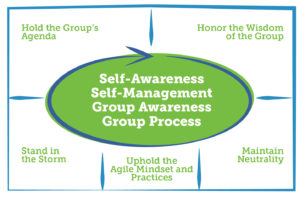During a recent two-day Virtual Team Facilitation workshop, one of our attendees Lisa created several visuals that demonstrate the activities we present during this 2-day workshop.
Find out what TeamCatapult shared in this Virtual Team Facilitation workshop on Day 1 of this Virtual Facilitation Workshop, here.

The Use of Slack Channels During Virtual Team Facilitation!
Slack is a useful tool for all remote teams. As a facilitator of virtual meetings, Slack can be your go-to tool to get conversations going and to keep them going.
- Use a Slack channel for checking in
- Lean in to listen
- Hear every voice
- Check in after breaks
The Mental Model and Decision Funnel!
When asking questions during a remote meeting, here are some things to keep in mind.
Know in advance what type of decision the team is aiming for:
- Consensus?
- Majority?
- Other?
Once a decision is made, it can be tempting to revisit it. You might need to remind the team of how and why they reached a decision. This is a good time to consider that the decision-making process needs to be reviewed and revised as well.
Evaluation vs Decision Making in Virtual Team Facilitation
Distinguish between evaluation and decision making.
Tools to Evaluate
- Dot voting
- Announce evaluation
- Use affinity mapping before dot voting
Do not rush through evaluation and remember that silence does not mean agreement! As the facilitator, you are there for support and to help the team reach agreement, ask questions like:
- Would anyone like to push back on…?
- What would you advocate for?
- Who would follow?
- Is there another move you’d like to make?
Decide
- In Mural, evaluate by color coding sticky notes against the criteria of the topic’s issues
- Consider using a grid sorting template
- Use gradients of agreement
These tools can help uncover what is holding people back and if necessary, generate a revised proposal that addresses concerns.
Virtual Team Facilitation Tips for Leaders
Here are three additional practical tips for leaders new to virtual team facilitation.
1 Transparency
Be transparent when something isn’t working as it should. Calmly accept and adapt and tell the attendees what is going on.
2 Ask WHO
Do not ask ‘Does anyone’ but instead ask
- WHO… needs more time?
- WHO… can push back?
3 Facilitator Assistant
Have one facilitator watching for participants who might get disconnected. Offer help in Slack or via email, text or whatever alternative means you’ve chosen to communicate.
More Virtual Team Facilitation Help is Available!
We are grateful for Lisa’s willingness to share these visuals with you, our audience, to provide you with a glimpse into the world of Virtual Team Facilitation
Whether it is you, your leadership team, or your company that needs help with Virtual Team Facilitation, TeamCatapult is able to lend a hand.
Please contact us today for more information for both private and public Virtual Facilitation Masterclass workshops.

